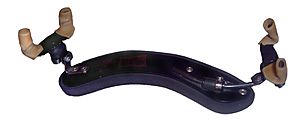Shoulder rest facts for kids
A shoulder rest is a helpful tool used by people who play the violin or the viola. It helps them hold their instrument comfortably. Shoulder rests can be made from different materials like wood, aluminium, carbon fiber, or plastic. This invention is fairly new, first appearing around the middle of the 20th century.
A shoulder rest usually attaches to the edge of the violin. It has small "feet" that are often covered with soft rubber. This helps it stay in place without scratching the instrument.
Contents
What is a Shoulder Rest?
A shoulder rest helps a musician hold their violin or viola. The instrument is held between the player's chin and shoulder. The shoulder rest adds a comfortable cushion in this space. It makes playing much easier and more relaxed.
Why Use a Shoulder Rest?
Using a shoulder rest helps players avoid squeezing their instrument too tightly. If a player squeezes the violin, their neck muscles can become very stiff. This can make it hard to play well. A shoulder rest allows the player's left hand to move freely. This is important for playing different notes and moving up and down the strings. It helps musicians play without worrying about dropping their instrument.
Different Ways to Hold the Instrument
While many modern violin and viola players use a shoulder rest, not everyone does. Some musicians might use a thin sponge or a cloth instead. Others might not use anything at all. This often depends on their body shape or even the type of clothes they wear. The main goal is always to hold the instrument comfortably and securely.
Shoulder Rest vs. Chinrest
It's easy to mix up a shoulder rest with a chinrest, but they are different. The chinrest is the part of the violin where the player rests their chin. The shoulder rest goes under the instrument, resting on the player's shoulder. Both are important for holding the instrument correctly.
Related pages


